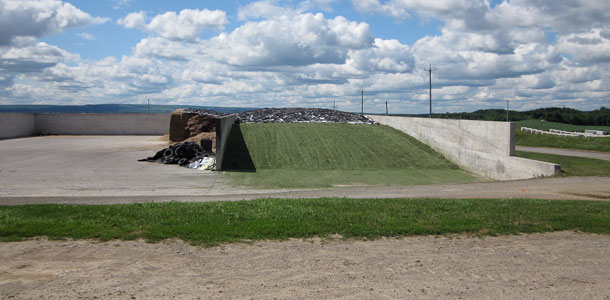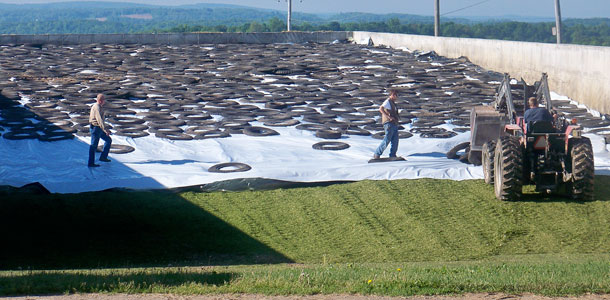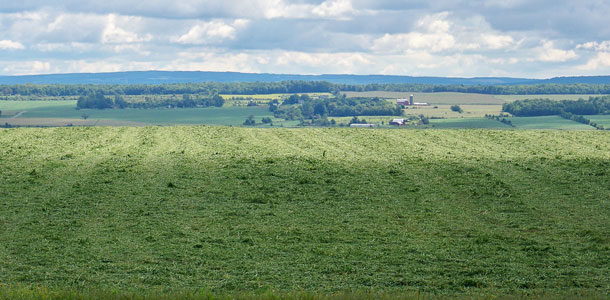They efficiently milk around the clock, using a Germania double-20 herringbone parlor. The farm raises youngstock and grows corn, alfalfa and peas on more than 1,800 acres of land.
Silage management, from seed to feed, ensures that high-quality silage produced from well-managed lands keeps these cows healthy and producing top-quality milk.
“Willard places a high priority on producing high-quality corn silage, so he covers all the fundamentals that go into producing a great crop year after year,” says Bill Cox, Cornell crop and soil science professor and researcher.
“He has been a partner in numerous field-scale research projects on corn silage, which I conducted on his farm, including row spacing, seeding rates, N rates and zone-tillage depths.”
Table Rock Farm has participated in many on-farm research trials throughout the years and continues to do so. The results of these trials have helped guide silage management decisions on the farm.
Employees are encouraged to attend producer meetings, interact with researchers and help improve farm practices. Adopting vertical tillage, which proved to be a smart move for the farm, was an employee-led initiative.
“Jeff Jordan, who has worked with Table Rock Farm for 40 years, became the true champion of vertical tillage on our farm, convincing the rest of the team, and my dad, that this was the right direction for the farm,” says Meghan Hauser, DeGolyer’s daughter and a partner in the farm.
Silage crop selection
Table Rock Farm has 1,015 acres of corn planted this season with all but 160 acres chopped for silage. Three hundred corn-silage acres are planted with BMR corn, the rest with standard varieties.
“For corn silage, we have been using Cornell trials, conducted on four locations around the state,” DeGolyer says. “We select on NDFd (neutral detergent fiber digestibility), yield, starch and dry matter comparison.
This trial, done by Cornell University, has been valuable to our farm but is not being done this year.”
DeGolyer “is only loyal to yield and quality data of a hybrid … he is not loyal to any seed company,” when selecting his hybrids, Cox says.
“Each truckload of silage taken off the field is put across scales so he knows how each hybrid performed, and how each field yields,” Cox says of DeGolyer’s silage management practices.
Other research, led by Cornell crop scientist Jerry Cherney, examined yield digestibility and heading date on several grass varieties and led DeGolyer to select meadow fescue as their grass choice to establish within the alfalfa.
They will have a total of 527 acres planted to alfalfa for silage this year and use leafhopper-resistant alfalfa.
Planting and harvesting
“Willard will adopt new technology, if it is beneficial,” Cox says. “He went with 15-inch-row corn back in the early to mid-1990s, and switched to a zone-tillage system in the early 2000s based on research data on his farm.
He is ready to plant each spring when (proper) conditions present themselves. He usually frost-injects his manure in March so he is ready in late April to plant.”
Frost tillage, DeGolyer says, is a great tool but only when very specific conditions are met. This year, he was not able to frost-till.
When planting corn on land that has been cropped for several years, DeGolyer does not use any chemical fertilizers.
Research performed by Quirine Ketterings of Cornell University has shown that starter fertilizer is not needed in these circumstances. Instead, injected manure is used in these fields.
In the alfalfa stand, manure is top-spread between cuttings as needed. Potassium fertilizer is typically needed during the first year of establishment.
Lime is applied as needed. Alfalfa stands are both spring-planted and summer-seeded, following a crop of peas.
Over the last two years, the corn silage yield has been 25.87 and 25.54 tons per acre. DeGolyer harvests the corn silage at 34 to 37 percent dry matter.
Last year was the farm’s first year using a kernel processor on corn silage. The chop length selected was 22 mm, but DeGolyer is considering going longer this fall. He looks for processing scores to be greater than 70 – an excellent score for starch digestibility.
The farm takes four cuttings of hay for silage. The first is typically cut around May 20. The fourth cut needs to be completed in late August or early September to allow the alfalfa stand to recover prior to a killing frost.
The 2013 alfalfa yield was 4 tons of dry matter per acre. Hay is cut without conditioning, spread 100 percent and merged with an Oxbo merger to be chopped, often the same day.
“Not conditioning reduces leaf loss, improves quality and reduces weather risk,” DeGolyer says. “Hay that is not conditioned does not absorb rain.”
He has attempted to conduct his own research, along with some neighboring farmers, to compare mower conditioners. However, it was difficult to compare the results.
This information exchange among neighboring farmers is another example of how DeGolyer is constantly seeking ways to improve his production and practices.
A Penn State shaker box is used on both corn and hay silage. This particle separator is used to evaluate the particle length of the ration, which in turn is indicative of the feed impact on rumen health and cud chewing, and on milk production and output.
Optimizing forage production is the main focus of work for manager Richard Sanford and his team. The emphasis is on doing the job right.
“The culture here is to wait for the right conditions and then put all hands together to get a timely job done,” he says. “If the crop isn’t ready, the crop team will wait until it is.”
Storing and feeding
Once the silage crop is harvested, proper packing in the bunk silos takes priority. Silage is stored in bunkers with adequate capacity for carryover.
The cows always receive consistent, fermented silage. The farm uses university-tested inoculants on all silage. Bunkers are covered with two layers of plastic.
A plastic oxygen barrier reduces the oxygen transfer rate, maximizing the silage feed quality.
Each morning, it is Doug Luce’s job to review what was fed to the cows overnight, walk the feedbunks and plan the day’s feeding.
Luce defaces the stored feed, beginning from 5 feet and working down to the bottom of the silage pile. This continues horizontally across the entire bunk.
Once this lower silage layer is fully defaced, the process begins on the upper layer of stored feed. In order to provide a better feed mix, with more homogenous silage, the buckets of defaced feed are piled together.
“Springers, fresh cows and high-production groups are fed BMR corn silage along with standard corn silage and hay crop silage,” DeGolyer says. “All other animals are fed standard corn silage and hay crop silage.”
DeGolyer credits his employees with most of his success in producing high-quality silage. He notes that they work hard to make sure bunks are covered ahead of any storm, work late or even on holidays when the crop requires it and pay attention to detail.
“We have excellent employees that monitor moisture packing, chop length and kernel processing,” DeGolyer says.
“The entire cropping team is always working to improve their knowledge base and take advantage of continuing education – attending extension meetings, shop-crop groups and learning from neighbors.”
From start to finish, the best silage management practices take diligence, ongoing review, responsiveness to new research and the dedication of the entire farm team.
Although Table Rock Farm makes it look easy, producing the highest-quality silage is the result of ongoing hard work. FG
Tamara Scully is a freelance writer based in New Jersey.
PHOTOS
PHOTO 1: Freshly mown hay drying. Haybines were modified to spread out the mown hay as widely as possible.
PHOTO 2: Covering third cutting. Table Rock uses step plastic when covering the bunk. A thin layer of plastic acts as an oxygen barrier, which is then covered by a thick white bunk cover.
PHOTO 3: A partially filled bunk silo.
PHOTO 4: Tire-to-tire coverage. Photos provided by Table Rock Farm.











